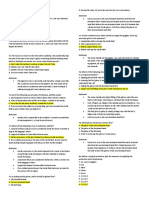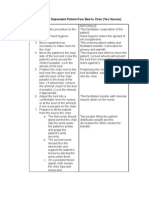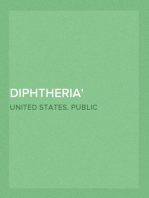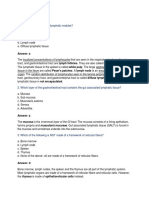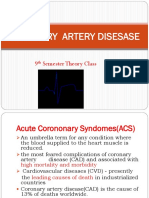Isolation Precaution
Isolation Precaution
Uploaded by
Kimberly Joy GregorioCopyright:
Available Formats
Isolation Precaution
Isolation Precaution
Uploaded by
Kimberly Joy GregorioOriginal Description:
Original Title
Copyright
Available Formats
Share this document
Did you find this document useful?
Is this content inappropriate?
Copyright:
Available Formats
Isolation Precaution
Isolation Precaution
Uploaded by
Kimberly Joy GregorioCopyright:
Available Formats
standard precautions: these are the necessary safety communicable disease contact precautions: (jeez, this looks like
like "wound" precautions are back......is
containment measures that must/ should be taken with all patients. that so?)
(formerly known as "universal")
1. wash your hands vigorously over the sink, for at least 1 minute, with before entering:
soap(*most important step in infection control, prevents most nosocomial 1.wash hands vigorously with soap, over the sink for at least 1 minute (you
infections, for which hospitals may not be compensated, with medicare can hum to yourself, a complete stanza of "twinkle,twinkle little star")
patients) 2. don gown good point of order, but if no splash of body fluids is possible,
2. don new pair of gloves (before coming in contact with anything wet, i.e. why use the gown? then gloves
broken skin, mucous membranes, blood, body fluids, freshly soiled/soaking
instruments, contaminated waste materials. upon entering:
3. wash hands again upon removal of gloves and between patients 1. use disposable equipment when possible why? if a wound culture hasn't
been done, there's no supporation...
2. when disposables are not available clean and disinfect all equipment before
removing from room that could be necessary when patients are caring for their
own colostomy, ileostomy, etc. i can't see why that would be necessary for
cutlery, or wheelchairs, etc.
transporting patient:
1. pt should perform hand hygeine (?just before leaving room?) with waterless
"soap",and wear a cleaner gown (shirt, if they have no open wound)
2. for direct contact with pt, nurse or care provider should wear a gown and
gloves. why, if no open wound?
3. notify receiving area of? - if transferring patient, need for isolation cart, if
there is a wound with mrsa
before leaving the patient's room:
1. place items to be removed from room, like soiled laundry, onto table near
inside of door, specimens in properly labelled as "contaminated"
in intact plastic bags for that purpose.
2. remove gloves then gown, pulling it off from back of neck, not front of
chest, if it needed to be used for a dressing change where splash of body fluids
was anticipated......
2. wash hands with soap over sink for 1 minute (humming or not)
contact precautions microorganisms:
1. antibiotic resistant organisms (methicillin resistant staphylococcus aureu
(mrsa), extended spectrum beta-lactamase (esbl), penicillin resistant
streptococcus pneumoniae (prsp), multi-drug resistant pseudomonas
aeruginosa (mdrp) which has not been treated for appropriate length of time
with antibiotic, and then is negative upon culture (about 4 days, total)
2. scabies
3. herpes zoster (shingles) localized
4. diarrhea, clostrididum difficile now, with bedpan use, splash ispossible,
therefore when assisting patient with removal of bedpan, a gown may be
necessary!
airborne/aka respiratory contact precautions: droplet (oral or nasal) contact precautions: same as contact/wound isolation
above, in addition to above negative pressure room procedures
before entering:
1.wash hands vigorously with soap, over sink for 1 minute before entering:
2. fit correct size n95 respirator (mask) over nose and mouth so that it is air 1. wash hands
tight 2. be sure patient has properly fitted n95 mask on and fitted well to facial
3. don gown then gloves contours, thendon mask and eye protection
3. don gown then gloves
*negative pressure isolation room keep door closed, with appropriate sign
on it, if permitted by hippa patient transport:
1. pt must perform hand hygeine if.....
look to see that room has been checked since last admission by 2. pt must wear a properly sized and fitted and cleaner gown, with clean sheet
engineering, to assure that laminar flow is present and working properly on top of him/her
3. *for direct contact with pt, nurse or care provider should wear a gown and
transporting patient: gloves.
1. patient must wear a well fitting n95 surgical or procedure mask and a 4. notify receiving area of the need for infection control equipment/negative
cleaner gown with clean sheet over body pressure room (if transfer)
2. patient must wash hands, if it's possible that he/she may touch something
outside their bed, enroute before leaving pt's room:
3. for direct contact with pt, nurse or care provider should wear a gown and 1. remove gloves then gown
gloves. (if sneezing or coughing could occur, with mask coming off) 2. wash hands
4. notify receiving area that their negative pressure room must be ready, 3. remove eye protection and mask
before leaving room with patient, if it's a transfer. (portable radiology 4. wash hands
equipment is preferable to going into x-ray department, if possible.)
droplet contact precautions microorganisms:
before leaving pt's room: 1. influenza (flu)
1. remove gloves then gown not n95 mask, bringing new ones in plastic bag 2. viral respiratory tract infections (adenovirus, parainfluenza, rhinovirus, rsv)
with you attached to bed, not on top of it, in case of splash of body fluids, 3. streptococcus group a pharyngitis, pneumonia, scarlet fever
contact with patient needed 4. neisseria meningitis invasive infections i though viral meningitis was
2. wash hands with soap vigorously for at least 1 minute acquired through droplet (respiratory) route
5. h. influenzae type b invasive infections ?
after leaving pt's room: 6. pertussis
1. shut door, or call another staff person to open and shut it for you, if your 7. rubella and rubeola
hands have items to be removed 8. mumps
2. wash hands vigorously with soap, over sink for at least 1 minute 9. diphtheria (while we are thinking of remote possibilities).
3. remove n95 mask, by the elastic cords, from behind your head and dispose 10. polio " " " " " " "
of it safely at entrance to room
4. wash hands again as always, if you handled items removed from room,
after leaving it
airborne contact precautions microorganisms:
1. measles (rubeola)
2. active tuberculosis (tb)
3. chicken pox (varicella-zoster virus)
4. herpes zoster (shingles) disseminated
5. a/h1n1 flu or other similarly contagious flu
You might also like
- Operating Room Orientation ManualDocument14 pagesOperating Room Orientation ManualHannah MercadoNo ratings yet
- Lesson Plan On Wound CareDocument5 pagesLesson Plan On Wound CareA J Fathima50% (2)
- Top 15 Commonly Asked Nursing Interview QuestionsDocument2 pagesTop 15 Commonly Asked Nursing Interview QuestionsKimberly Joy Gregorio100% (1)
- Checklist 17: Head-to-Toe Assessment Disclaimer: Always Review and Follow Your Hospital Policy Regarding This Specific Skill. Safety ConsiderationsDocument3 pagesChecklist 17: Head-to-Toe Assessment Disclaimer: Always Review and Follow Your Hospital Policy Regarding This Specific Skill. Safety ConsiderationsKimberly Joy GregorioNo ratings yet
- Checklist 17: Head-to-Toe Assessment Disclaimer: Always Review and Follow Your Hospital Policy Regarding This Specific Skill. Safety ConsiderationsDocument3 pagesChecklist 17: Head-to-Toe Assessment Disclaimer: Always Review and Follow Your Hospital Policy Regarding This Specific Skill. Safety ConsiderationsKimberly Joy GregorioNo ratings yet
- Approach To Pediatric ECGDocument5 pagesApproach To Pediatric ECGMateen ShukriNo ratings yet
- DfahDocument7 pagesDfahexpert 60No ratings yet
- Principles of MLS 2 LABDocument12 pagesPrinciples of MLS 2 LABSab ParkNo ratings yet
- ISOLATION - Hand HygieneDocument16 pagesISOLATION - Hand HygieneAnna Carmela Pillora MelendezNo ratings yet
- ReviewerDocument1 pageReviewerAira Jean SantiagoNo ratings yet
- TMC OrientationDocument4 pagesTMC OrientationJennifer HerediaNo ratings yet
- Wound DressingsDocument7 pagesWound DressingsJaymi MacapagalNo ratings yet
- NCM 07 Rle ReviewerDocument5 pagesNCM 07 Rle ReviewerWencel Allyza SepilloNo ratings yet
- Medical Health Care Trifold Brochure in Blue White Corporate Geometric StyleDocument2 pagesMedical Health Care Trifold Brochure in Blue White Corporate Geometric StyleKezia Keren Dela CruzNo ratings yet
- 3 - Safety and Infection ControlDocument7 pages3 - Safety and Infection ControlMylen TripoliNo ratings yet
- PMLS-2-LESSON-2 NoDocument6 pagesPMLS-2-LESSON-2 NoVoid MelromarcNo ratings yet
- Surgical DressingDocument7 pagesSurgical DressingGabz GabbyNo ratings yet
- I. Hand Hygiene A. Hand Hygiene TechniqueDocument3 pagesI. Hand Hygiene A. Hand Hygiene TechniqueHazem NusiratNo ratings yet
- Skills Demo Beth BathDocument3 pagesSkills Demo Beth Bathphrantsh2No ratings yet
- Skin Preparation For Osteosynthesis of A Closed Tibia FractureDocument3 pagesSkin Preparation For Osteosynthesis of A Closed Tibia Fracturebagus lazuardiNo ratings yet
- Gowning and GlovingDocument7 pagesGowning and GlovingJames EvangelistaNo ratings yet
- Manual of Procedures 2nd Year 1st SemDocument28 pagesManual of Procedures 2nd Year 1st SemJan Erika AlmeronNo ratings yet
- Steps in Dressing ChangeDocument4 pagesSteps in Dressing ChangeSophia AbdullahNo ratings yet
- Module 1 - 3 PMTP LabDocument2 pagesModule 1 - 3 PMTP LabPeach Mango PieNo ratings yet
- Complete Bed Bath RationalesDocument7 pagesComplete Bed Bath RationalesHans TrishaNo ratings yet
- Care of WoundsDocument6 pagesCare of WoundsKimpoy Tu-osNo ratings yet
- Medical-Surgical Nursing 1: Pamantasan NG Lungsod NG MaynilaDocument3 pagesMedical-Surgical Nursing 1: Pamantasan NG Lungsod NG MaynilaAye DumpNo ratings yet
- Checklist Wound CareDocument3 pagesChecklist Wound CareJenny Agustin FabrosNo ratings yet
- Demonstration On Bed BathDocument8 pagesDemonstration On Bed Bathsujatamudi007No ratings yet
- Wound DressingDocument5 pagesWound Dressingsinuaish syaNo ratings yet
- Wound DressingDocument11 pagesWound DressingKRIZIA ANE A. SULONGNo ratings yet
- MOdule 1 Common Competencies GRADE 12Document18 pagesMOdule 1 Common Competencies GRADE 12Miko AbadNo ratings yet
- Infection Control - 091115Document43 pagesInfection Control - 091115Sara MoustafaNo ratings yet
- Public Health Information Sheet: General Infection Control MeasuresDocument4 pagesPublic Health Information Sheet: General Infection Control MeasuresAjay Pal NattNo ratings yet
- Funda RleDocument4 pagesFunda RleXerxes DejitoNo ratings yet
- Lesson 2 Micro MidtermDocument6 pagesLesson 2 Micro MidtermKatrina CeledioNo ratings yet
- Reviewer in CHNN (Rle) : "Bag Technique"Document31 pagesReviewer in CHNN (Rle) : "Bag Technique"Claudine Jo B. Talaboc100% (1)
- Practice Questions - PERIOPDocument4 pagesPractice Questions - PERIOPKaren BlancoNo ratings yet
- Caring For A Hemovac DrainDocument15 pagesCaring For A Hemovac DrainJaily Mariano0% (1)
- Infection Control Part IDocument3 pagesInfection Control Part IFadz HadjiriNo ratings yet
- Mode of transmissionDocument6 pagesMode of transmissionOrville BariringNo ratings yet
- DONNING and DoffingDocument3 pagesDONNING and DoffingChang GelvoleoNo ratings yet
- PMLS 2 Act.1Document3 pagesPMLS 2 Act.1jhanemil240No ratings yet
- Surgical Hand Preparation With Antimicrobial Soap and WaterDocument10 pagesSurgical Hand Preparation With Antimicrobial Soap and Watercayla mae carlosNo ratings yet
- Donning and Doffing ChecklistDocument7 pagesDonning and Doffing ChecklistMary Cueva50% (2)
- Sterile Gowning and Closed Gloving TechniqueDocument6 pagesSterile Gowning and Closed Gloving TechniqueJames Abendan100% (1)
- Basic Infection ControlDocument7 pagesBasic Infection ControlRanzen ReolNo ratings yet
- How To Safely Collect Blood Samples From Persons Suspected To Be Infected With Highly Infectious Blood-Borne Pathogens (E.g.Document7 pagesHow To Safely Collect Blood Samples From Persons Suspected To Be Infected With Highly Infectious Blood-Borne Pathogens (E.g.مقدم خالدNo ratings yet
- Skills of The 2nd WeekDocument22 pagesSkills of The 2nd Weekalharbimanar20No ratings yet
- Transferring A Dependent Patient From Bed To ChairDocument5 pagesTransferring A Dependent Patient From Bed To Chairapi-26570979No ratings yet
- REYES, ANNA - MS 1 PERIOP. GowningDocument3 pagesREYES, ANNA - MS 1 PERIOP. GowningAnna Sofia Reyes100% (3)
- Gowning and Gloving ChecklistDocument6 pagesGowning and Gloving ChecklistCriseth RubioNo ratings yet
- Immuno Week 1 Lab SafetyDocument5 pagesImmuno Week 1 Lab SafetyJAIRA RIEYELLE LIPANANo ratings yet
- 3promoting Asepsis and Preventing InfectionDocument20 pages3promoting Asepsis and Preventing InfectionKaren Joy MagbanuaNo ratings yet
- Pbox 9-5 Evidence Based Practice Guidelines For The Prevention of Ventilator Associated Pneumonia (Vap)Document2 pagesPbox 9-5 Evidence Based Practice Guidelines For The Prevention of Ventilator Associated Pneumonia (Vap)Theresia FlorensiayssNo ratings yet
- Operation Theater TechniquesDocument34 pagesOperation Theater TechniquesSoraisham Kiranbala DeviNo ratings yet
- Universal PrecautionsDocument4 pagesUniversal PrecautionsRasheena Alaja JainalNo ratings yet
- Nclex Questions RNDocument45 pagesNclex Questions RNspringday_2004100% (8)
- Checklist On Donning (Putting On) PPE: Personal Protective Equipment (PPE)Document5 pagesChecklist On Donning (Putting On) PPE: Personal Protective Equipment (PPE)Jan Oliver YaresNo ratings yet
- RationalemangmangDocument13 pagesRationalemangmangBeyaaa GingoyonNo ratings yet
- Monkeypox ProtocolDocument10 pagesMonkeypox ProtocolrhferanielNo ratings yet
- DIY Homemade Medical Face Mask: the Complete Guide on How to Make Your Own Homemade, Washable and Reusable Medical Face Mask: Diy Homemade Tools, #1From EverandDIY Homemade Medical Face Mask: the Complete Guide on How to Make Your Own Homemade, Washable and Reusable Medical Face Mask: Diy Homemade Tools, #1No ratings yet
- Easy Peasy Homemade Sanitizer Wipes: A Quick Guide with Visuals for Making Disposable Sanitizing Wipes Against MicrobesFrom EverandEasy Peasy Homemade Sanitizer Wipes: A Quick Guide with Visuals for Making Disposable Sanitizing Wipes Against MicrobesNo ratings yet
- Diphtheria how to recognize the disease, how to keep from catching it, how to treat those who do catch itFrom EverandDiphtheria how to recognize the disease, how to keep from catching it, how to treat those who do catch itNo ratings yet
- Blood Test Results: CMP Explained: Comprehensive Metabolic Panel (CMP)Document1 pageBlood Test Results: CMP Explained: Comprehensive Metabolic Panel (CMP)Kimberly Joy GregorioNo ratings yet
- Identify The Cause To Control The SymptomDocument3 pagesIdentify The Cause To Control The SymptomKimberly Joy GregorioNo ratings yet
- Birth Defects PDFDocument24 pagesBirth Defects PDFKimberly Joy GregorioNo ratings yet
- Allergy Medications: Know Your Options: AntihistaminesDocument6 pagesAllergy Medications: Know Your Options: AntihistaminesKimberly Joy GregorioNo ratings yet
- 220 Nursing Bullets: Fundamentals of Nursing Reviewer 1: TopicsDocument8 pages220 Nursing Bullets: Fundamentals of Nursing Reviewer 1: TopicsKimberly Joy GregorioNo ratings yet
- Tentative Go Live Date September XX, 2012Document22 pagesTentative Go Live Date September XX, 2012Kimberly Joy GregorioNo ratings yet
- Bacterial Growth Requirement and CultivationDocument65 pagesBacterial Growth Requirement and CultivationKimberly Joy GregorioNo ratings yet
- Bacterial Growth Requirement and CultivationDocument65 pagesBacterial Growth Requirement and CultivationKimberly Joy GregorioNo ratings yet
- Endocrine System ReviewerDocument23 pagesEndocrine System ReviewerKimberly Joy GregorioNo ratings yet
- Lymphatic System ReviewerDocument9 pagesLymphatic System ReviewerKimberly Joy Gregorio100% (1)
- Cerebrovascular Accident (Stroke) : - Large Artery Thromboses Are - Small Penetrating EmboliDocument7 pagesCerebrovascular Accident (Stroke) : - Large Artery Thromboses Are - Small Penetrating EmboliKimberly Joy GregorioNo ratings yet
- CC1 Lab. Notes (Carbo)Document5 pagesCC1 Lab. Notes (Carbo)Kimberly Joy GregorioNo ratings yet
- EBOLA CASE sTUDY PDFDocument7 pagesEBOLA CASE sTUDY PDFNADEEM SIDDNo ratings yet
- Supplement Digital Content 1. Surgery Codes For A LaparotomyDocument6 pagesSupplement Digital Content 1. Surgery Codes For A LaparotomyMaja JeppesenNo ratings yet
- Four Big Pollution Diseases of Japan - Wikipedia, The Free Encyclopedia PDFDocument6 pagesFour Big Pollution Diseases of Japan - Wikipedia, The Free Encyclopedia PDFudayngNo ratings yet
- Spinal TractionDocument37 pagesSpinal TractionDibyendunarayan BidNo ratings yet
- DSM 5 Adhd Fact SheetDocument2 pagesDSM 5 Adhd Fact SheetAnonymous Pj6OdjNo ratings yet
- Management of Penile Fracture: Ahmad M. El-Taher, Hassan A. Aboul-Ella, Mohamed A. Sayed, and Atef A. GaafarDocument3 pagesManagement of Penile Fracture: Ahmad M. El-Taher, Hassan A. Aboul-Ella, Mohamed A. Sayed, and Atef A. GaafarTeja LaksanaNo ratings yet
- Dysphagia NotesDocument5 pagesDysphagia Notesapi-31372205650% (2)
- Guillain Barre Syndrome: Molebatsi TheletsaneDocument16 pagesGuillain Barre Syndrome: Molebatsi TheletsaneSri KombongNo ratings yet
- Acute Coronary SyndromeDocument84 pagesAcute Coronary SyndromeRinkita MallickNo ratings yet
- NRNP PRAC 6635 Comprehensive Psychiatric Evaluation Template 3Document6 pagesNRNP PRAC 6635 Comprehensive Psychiatric Evaluation Template 3superbwriters10No ratings yet
- AbscessDocument2 pagesAbscessjegan555No ratings yet
- Pediatric Supraventricular Tachycardia Case PresentationDocument23 pagesPediatric Supraventricular Tachycardia Case Presentationapi-602288180No ratings yet
- Investigating The Prevalence of Delirium After The Coronary Artery Bypass Graft (Cabg) and Its Risk Factors in Patients in Basra Oil Cardiac Center Hospital During 2023 From January To MayDocument13 pagesInvestigating The Prevalence of Delirium After The Coronary Artery Bypass Graft (Cabg) and Its Risk Factors in Patients in Basra Oil Cardiac Center Hospital During 2023 From January To Mayindex PubNo ratings yet
- Chapter 1 Title DefenseDocument5 pagesChapter 1 Title DefenseTom Ricsan Delos SantosNo ratings yet
- IAEA HHS 14 PlanningNationalRadiotherapyServices APracticalToolDocument100 pagesIAEA HHS 14 PlanningNationalRadiotherapyServices APracticalToolCleber N SouzaNo ratings yet
- Musofa Fever Dewasa Praud IIIDocument17 pagesMusofa Fever Dewasa Praud IIItowiiiNo ratings yet
- Vegeta To Overcome ConstipationDocument11 pagesVegeta To Overcome ConstipationLucia Ida Ayu KristianaNo ratings yet
- Special MicrobiologyDocument68 pagesSpecial MicrobiologyrefuapalackyNo ratings yet
- Antiviral Drugs Aspects of Clinical Use and Recent AdvancesDocument206 pagesAntiviral Drugs Aspects of Clinical Use and Recent AdvancesJosé RamírezNo ratings yet
- Neonatal Resuscitation Current IssuesDocument11 pagesNeonatal Resuscitation Current Issuesjimmy tNo ratings yet
- Classification and Diagnosis of Hypertensive Disorders of PregnancyDocument6 pagesClassification and Diagnosis of Hypertensive Disorders of PregnancyZAHID AHMED KHANNo ratings yet
- Assessment of Eyes and EarsDocument1 pageAssessment of Eyes and EarsBabyJane GRomeroNo ratings yet
- AppendectomyDocument4 pagesAppendectomyJillary LlagunoNo ratings yet
- Comm 119 - Persuasive SpeechDocument5 pagesComm 119 - Persuasive SpeechLuis Fernando Morales100% (1)
- Kode Icd Dokter PKMDocument78 pagesKode Icd Dokter PKMnovitaNo ratings yet
- CD002748Document132 pagesCD002748Dewi PaatNo ratings yet
- Comparison of Tzanakis Score Vs Alvarado Score in The Effective Diagnosis of Acute AppendicitisDocument3 pagesComparison of Tzanakis Score Vs Alvarado Score in The Effective Diagnosis of Acute AppendicitisMahlina Nur LailiNo ratings yet
- (GYNE) Ovarian Neoplasms-Dr. Delos Reyes (MRA)Document9 pages(GYNE) Ovarian Neoplasms-Dr. Delos Reyes (MRA)adrian kristopher dela cruzNo ratings yet




































